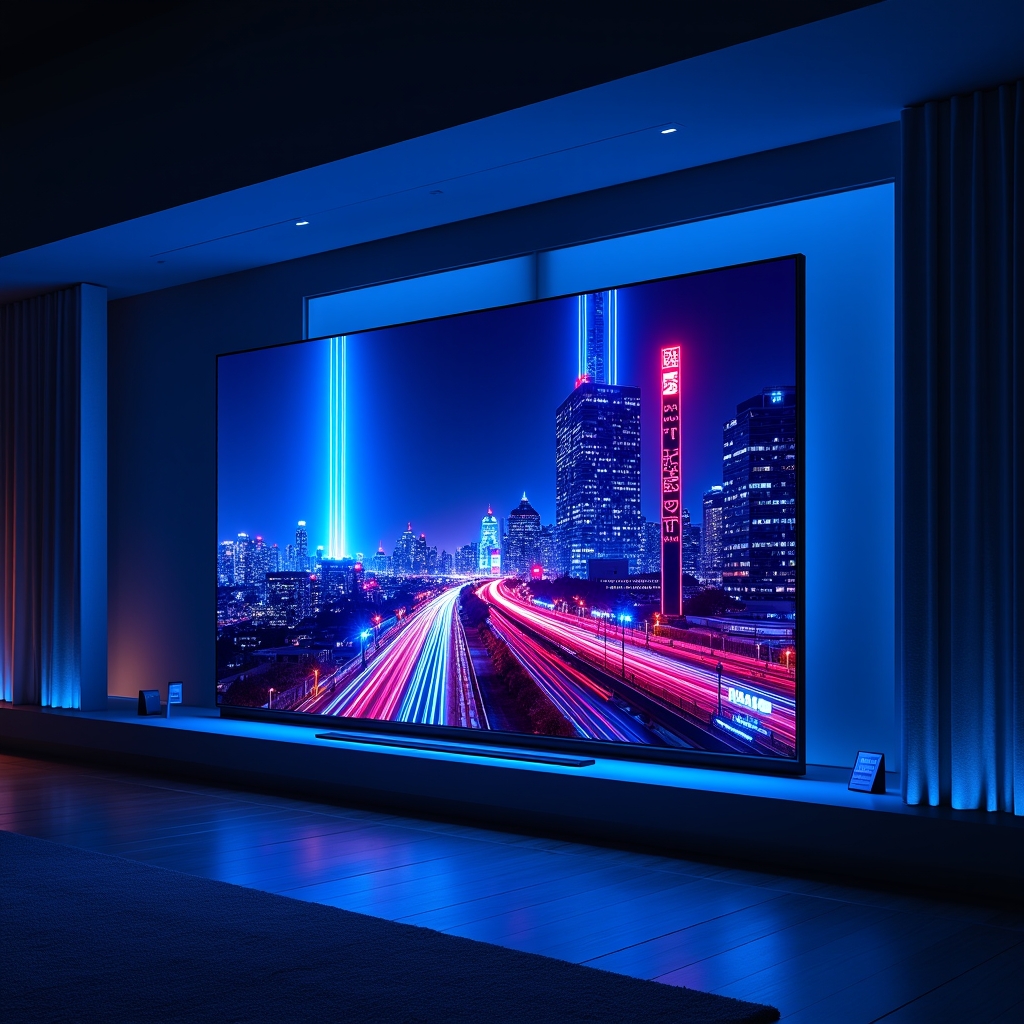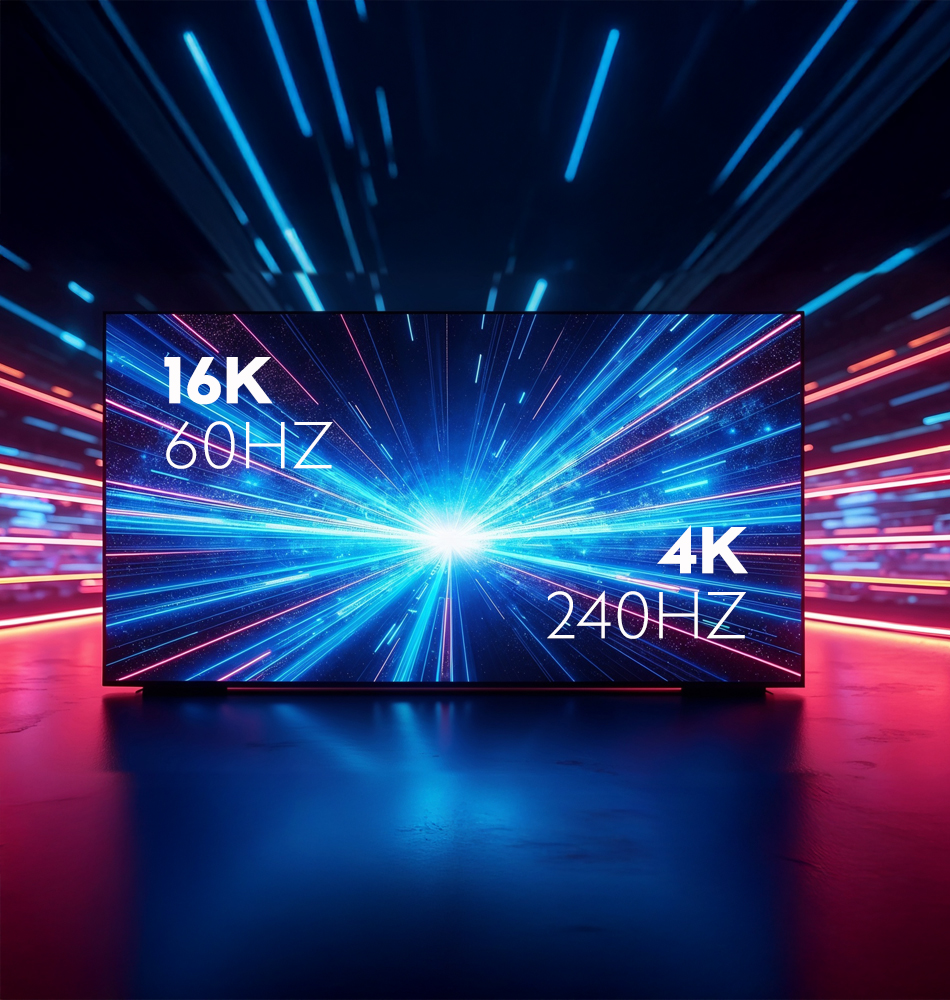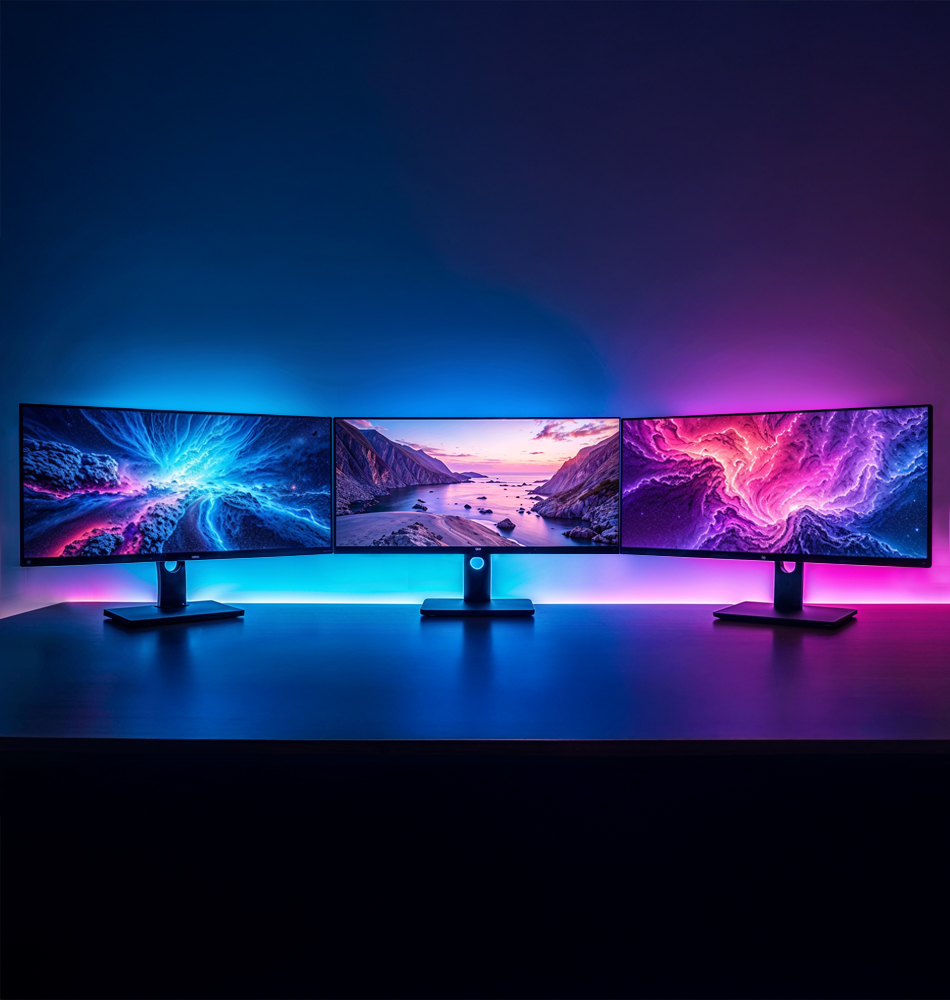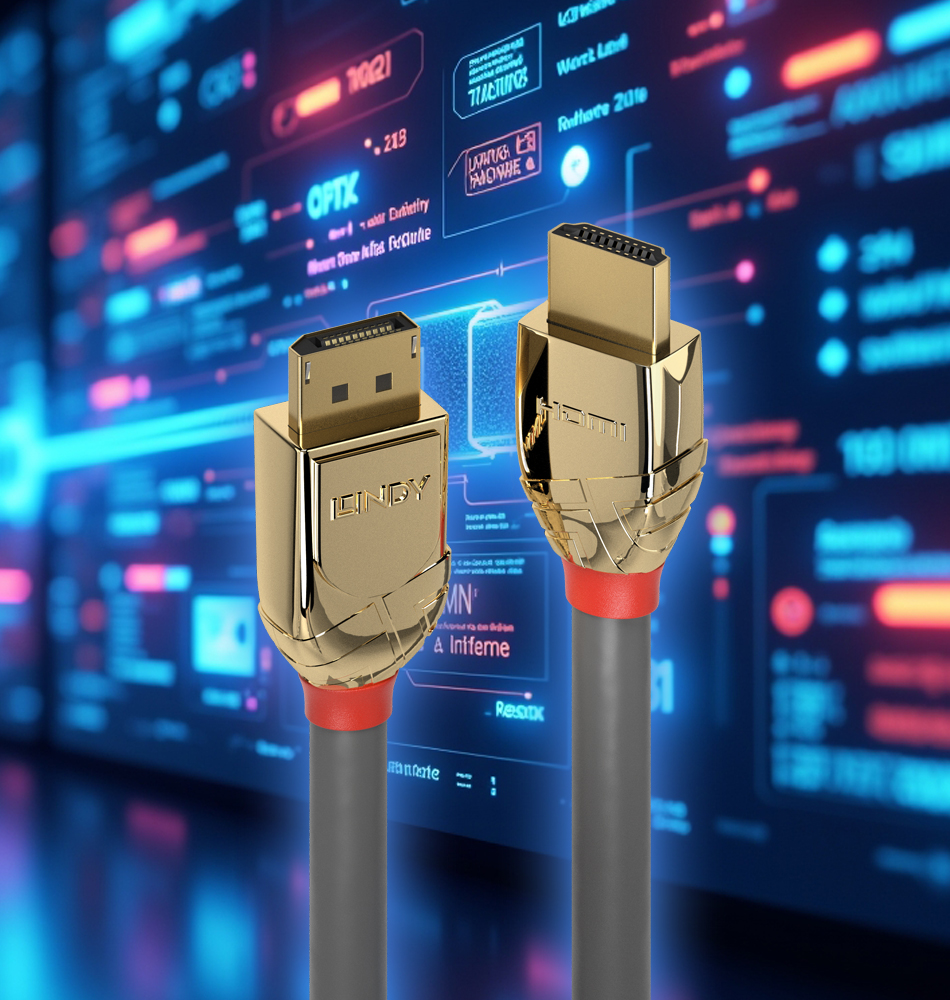
DisplayPort™ Version 2.1
Progress for the Highest Demands
Since its introduction in 2006, DisplayPort™ has established itself as a powerful standard for transmitting audio and video signals—particularly in professional AV and gaming environments. Developed by VESA (Video Electronics Standards Association), DisplayPort™ was designed from the outset to support high resolutions, fast refresh rates, and advanced features.
Over the years, the technology has continuously evolved, and today, DisplayPort™ 2.1 supports data rates of up to 80 Gbps, resolutions up to 16K, and cutting-edge features for multi-monitor setups. This makes DisplayPort™ a future-proof solution for anyone seeking maximum image quality and flexibility.
What is
DisplayPort™ 2.1?
DisplayPort™ 2.1 is the latest standard in DisplayPort™ technology, developed by VESA to meet the highest demands for image quality, bandwidth, and flexibility. With an impressive bandwidth of up to 80 Gbps, DisplayPort™ 2.1 enables resolutions up to 16K and 4K at 240 Hz—with full HDR support, thanks to DSC (Data Stream Compression). Especially for professionals, creatives, and gamers, DisplayPort™ 2.1 unlocks new dimensions in image fidelity, color space, and performance.
The Key Innovations
OF DisplayPort™ 2.1
1. Higher Bandwidth
Up to 80 Gbps
With UHBR (Ultra High Bit Rate), DisplayPort™2.1 achieves a maximum bandwidth of 80 Gbps—more than twice that of DisplayPort™ 1.4. This enormous data rate enables lossless transmission of ultra-high-resolution content, even at high refresh rates. Users benefit from crystal-clear images, smooth gameplay, and the ability to run multiple monitors at the highest quality simultaneously—by using visually lossless compression algorithms.


2. 16K at 60 Hz
4K at 240 Hz
DisplayPort™ 2.1 provides enough bandwidth to support resolutions of up to 16K (15,360 × 8,460 pixels) at 60 Hz or 4K (3,840 × 2,160 pixels) at up to 240 Hz—perfect for high-end gaming and professional applications. This level of performance unlocks new creative possibilities for 3D design, video production, and CAD, where even the smallest details are rendered with razor-sharp precision. For gamers, 240 Hz in 4K delivers ultra-smooth motion and a new level of immersion.
3. DSC 1.2a and FEC
Efficiency Without Quality Loss
With Display Stream Compression (DSC) 1.2a, even higher resolutions and frame rates can be transmitted with virtually no loss. Combined with Forward Error Correction (FEC), DSC ensures efficient data transmission while maintaining the highest image quality. This helps prevent visual artifacts, which is especially crucial for fast-moving content like gaming or video playback. This technology enables more flexible setups while ensuring maximum visual precision.


4. More Displays, Fewer Cables
Multi-Stream Transport (MST)
MST allows multiple monitors to be connected through a single DisplayPort™ connection—either through daisy-chaining or using hubs. DisplayPort™ 2.1 enhances this functionality with increased bandwidth, enabling the simultaneous use of multiple high-resolution displays. This makes it an ideal solution for professional work environments with multi-monitor setups, where efficiency, organization, and high image quality are essential.
5. Compatible with USB-C and Thunderbolt
Flexible and Future-Proof
DisplayPort™ 2.1 is fully compatible with USB-C and Thunderbolt 4 interfaces. This allows modern devices such as laptops, tablets, and docking stations to seamlessly transmit high-resolution content, even in mobile setups. This flexibility makes DisplayPort™ 2.1 the perfect choice for modern work environments, where powerful, space-saving, and versatile connectivity solutions are essential—without compromising on image quality.

Benefits of DisplayPort™ 2.1
for Professionals
and Gamers
Whether you’re rendering complex 3D models, editing high-resolution videos, or pushing the limits of modern gaming, DisplayPort™ 2.1 provides the technical foundation you need. With support for high resolutions, HDR formats, and ultra-fast refresh rates, every detail is displayed with stunning precision, fluidity, and dynamic range.

DP 2.1 vs. HDMI 2.1
A Comparison
While HDMI 2.1 is primarily optimized for home theater and consoles, DisplayPort™ 2.1 is designed for professionals and demanding users. DisplayPort™ offers higher bandwidth, more flexible connectivity options (such as MST and USB-C), and supports higher resolutions without compression. Additionally, DisplayPort™ connectors feature a built-in latch to help prevent accidental disconnections. Both standards have their strengths—DisplayPort™ excels particularly in multi-monitor setups and in delivering the highest frame rates.
Frequently Asked Questions (FAQs)
About Displayport™ 2.1
1. Can I connect older devices with DisplayPort™ 2.1 cables?
Yes, DisplayPort™ 2.1 is backward compatible with older versions like 1.4 or 1.2. However, you’ll only benefit from the new features if both the source device and the display support DisplayPort™ 2.1.
2. Do I need a special cable for DisplayPort™ 2.1?
Yes, to fully utilize the 80 Gbps bandwidth of DisplayPort™ 2.1, you’ll need a certified cable with UHBR (Ultra High Bit Rate) support to handle the required data rates.
3. What is the difference between DisplayPort™ over USB-C and the traditional DP connector?
DisplayPort™ can be transmitted through both the classic DisplayPort™ connector and USB-C—this is known as DisplayPort™ Alternate Mode (Alt Mode).
The major advantage of DisplayPort™ over USB-C is that it allows video, audio, data, and power signals to be transmitted through a single, compact cable—ideal for modern laptops, tablets, and docking stations. The technical performance remains the same: DisplayPort™ 2.1 can deliver up to 80 Gbps over USB-C, provided both the cable and devices support the full bandwidth.
On the other hand, the traditional DP connector offers a stable connection with a locking mechanism and is often found in desktop setups where robustness and secure installation are important.
4. Which Port is better: DisplayPort™ 2.1 or HDMI 2.1?
Whether DisplayPort™ 2.1 or HDMI 2.1 is the better choice depends heavily on the intended use. HDMI 2.1 was primarily developed for home theater and gaming environments—it’s ideal for TVs, soundbars, gaming consoles like the PlayStation 5 or Xbox Series X, and streaming devices. HDMI transmits not only video and audio but also features like eARC (Enhanced Audio Return Channel) and CEC, which offer significant advantages in living room setups.
DisplayPort™ 2.1, on the other hand, is aimed primarily at demanding users and professionals, such as those with multi-monitor workstations or creative applications requiring the highest resolutions. DP 2.1 offers much higher bandwidth (up to 80 Gbps), supports higher frame rates and resolutions (up to 16K), and transmits content uncompressed or with visually lossless compression (DSC)—ideal for razor-sharp images and smooth performance. Features like MST (Multi-Stream Transport) and USB-C compatibility make DisplayPort™ especially versatile.
In short: For home theater and consoles, choose HDMI 2.1. For high-performance computing and professional use, go with DisplayPort™ 2.1. Both standards are powerful, but their strengths lie in different application areas.
Conclusion: DisplayPort™ 2.1
Ready for the Future
DisplayPort™ 2.1 offers a future-proof solution for those who demand the highest image quality and maximum flexibility. With support for cutting-edge resolutions, fast refresh rates, and lossless audio and video, DisplayPort™ 2.1 sets new standards in digital connectivity.

